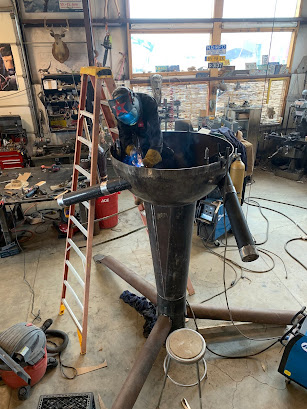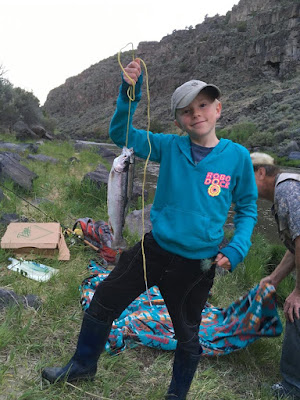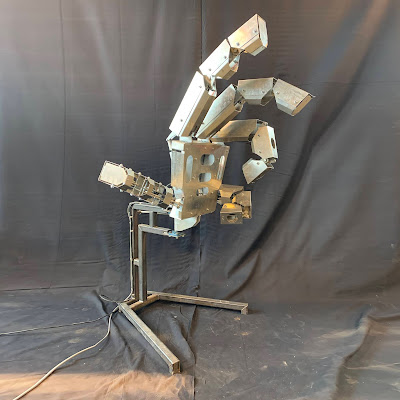I have been doing a 'spring cleaning' kind of thing throughout the summer and fall - cleaning out my shipping containers, reorganizing them, and moving them around the land into better configurations.
Christina and I are building her a new studio (for the 'clean' arts - drawing, painting, sewing). It's almost done. I'm jealous. It's going to be a nice studio.
I converted the K-Shack (our guest shack, the oldest building on this land) into a temporary painting studio for myself. It's not ideal, but it's not bad.
I started painting again. It is difficult to find time to paint, but I'm working on that as well... I made a schedule!
Many years ago, I thought to myself "you know, I should be a painter. They have it easy... just painting images and putting them on walls. No giant machinery, no underground performances, no broken diesel engines. But.. what the hell would I paint?" I had some pretty stupid ideas back then about what I might paint. Luckily, I recognized these ideas as stupid and did not pursue it.
But then, three years ago, in Europe, cracked open by the culture in which we were immersed, a culture of sculpture, of painting and of the human body, I started to realize I actually had something to say. I dreamed up paintings. And then more paintings. Painting, as an idea... the 'idea of painting,' seemed to offer a more direct and immediate outlet for personal messages than any other medium I'd yet engaged with. And suddenly there were personal messages that felt worth expressing.
About a year ago, I switched therapists. It was a great move; I was stuck in a rut with my previous one. In this last year I've made incredible progress with my new therapist; I keep setting up targets and knocking them down.
I am now close to, or have perhaps even already arrived at a unifying theory which finally ties together and makes sense of my long fascination with powerful / beautiful / fierce / angry women, my fascination with expressions of extreme emotion, and my uneasy relationship with my own emotional landscape. This has been a revelation. (And like any really good theory, this one suddenly gives new context to disparate bits of data which previously seemed random and disconnected; my interests in Francis Bacon, Alexander McQueen, and Wonder Woman have a new and clear meaning. Camille Paglia's ideas as set forth in Sexual Personae not only fit nicely with the theory, but also helped form it.)
Anyone who reads this blog with any regularity knows that I place a great importance on mystery when it comes to the generation of new art ideas; I believe (or have believed) that true inspiration comes from the subconscious miasma. Consequently, part of me is afraid that, now that I have a better understanding of the psychological currents which drive me to want to paint, my will to paint may diminish. If the act of painting is tantamount to self-discovery and self-analysis, but the discovery and analysis has already been done through therapy, reading, and introspection, well then... why paint? On the other hand, these new layers of self-awareness have arrived contemporaneously with an increased desire to paint. So this fear is probably unjustified; it is probably just another excuse not to paint (and Jeez knows I've gone through plenty of those!). And in any case, just because one mystery has been solved, who is to say that there are not more mysteries around the corner?
Interestingly, I feel generally less comfortable these days discussing art which features the nude body than I did a few years ago. I think this is probably because I no longer reside in a culturally rich place where the nude is normalized by ubiquity and shameless celebration. Well, whatever... I'll push through that and say that I have a newfound appreciation of the work of Jock Sturges and Gerhard Riebicke. A few weeks ago, in order to facilitate the paintings I'm currently working on (on Mondays, Tuesdays, and Thursdays!), I took some photographs of one of the models from our weekly drawing group. I was looking for some pretty specific poses and attitudes, and this got me looking at more nude photography by other artists.
Jock Sturges walks a fine line, in my opinion. His photographs are some of the very few out there that are not completely ruled by the male gaze... and yet... he is photographing beautiful young women in the buff. A fine line, indeed. He sees his own work as the antithesis of 'pin-up' style photography, in which the identity of the subject is made subservient to the effect she produces in the viewer (typically some sort of sexual fantasy). He believes that his own work instead prioritizes the identity... the reality... of the subject. It is as if his work is saying: "Look, these women (and men) are real people. And, they are sexy. In fact, if you (the viewer) are able to handle the fact that you are looking at real people with real identities separate from your fantasy of who you want them to be, you might just have a richer experience than you would otherwise looking at more traditional nude photography." Since discovering the work of Sturges, I find most 'normal' nude photography quite boring, overrun as it is by the ubiquitous solipsism of the male gaze.
I have an idea to create a scientific (or quasi-scientific) ranking system, a scale, if you will, through which images of women (in popular culture; advertising, art, photography, etc.) could be evaluated on a handful of criteria, each of which could be assigned a number value from 1 to 10 along a continuum from something like 'submissive' to 'assertive.' The various criteria would be something like 'posture,' 'gaze,' 'head angle,' etc. As an example, an image in which the woman's posture was the traditional pin-up 'arched back, ass out, boobs out' would be ranked relatively low on that scale, while a neutral posture or a more typically male posture featuring hands-on-hips and forward shoulders would rank with a higher number. As with any other similar evaluation scale, the numbers would then be averaged to yield an overall number, which would rank the image according to its... its what? What would the scale reveal? What would it be called? The Ristow Assertiveness Scale? The male-gaze-o-meter? The Submissiveness and Assertiveness Scale in Imagery of Women in Popular Culture? (The SASIWoPoC) Haha, maybe I've got to work on that.
Jock Sturges's images would rank quite high on the scale.
______________________________
Speaking of ranking scales, I am always interested in the psychology of politics. Basically I am interested in what makes conservative people the way they are (because it feels like a mystery to me.) In a way, the driving question is "Why would someone vote for Trump?" My belief is that there are a variety of personal characteristics which would cause someone to vote for a character like him. (And yes, I know the election is over!)
First, wealth. The rich have a good reason to vote for Trump, because he believes in low taxes for the wealthy, as well as the right of the wealthy to use loopholes in order to pay even less (if we are to judge by his behaviors) and so these people therefore have a genuine self-interest in seeing him in office (assuming they are not altruists, heaven forbid!)
Second, racists and misogynists and xenophobes in general. People like to see their own values reflected in their political representatives, so anyone possessed of these distasteful attitudes will gravitate towards Trump because he too expresses these attitudes.
Third, authoritarian personality types. To me, this is far and away the most interesting group of people because with this category we are venturing into psychology. There was a fascinating poll conducted in 2015 which sought to predict who would vote for Trump in the 2016 election. Many questions were asked (gender, race, income, etc.) but the four questions which predicted with the most accuracy whether or not people intended to vote for him were: When it comes to raising a child, is it more important for that child to be 1) respectful or independent? 2) obedient or self-reliant? 3) well-behaved or considerate? 4) well-mannered or curious? With a high degree of accuracy, it was found that respondents who chose the first option to these four questions were the ones who were planning on casting a vote for Trump. And guess what? In earlier research these four questions were found to correspond highly with the authoritarian personality type.
This personality type was first clinically identified in the aftermath of World War II in an effort to understand the behavior of Germans and Italians and others during that time. Early indicators of this personality type were excessively complicated but were later simplified and experimentally proven to include:
Authoritarian submission: a high degree of submissiveness to authorities perceived to be legitimate.
Authoritarian aggression: a general aggressiveness directed at deviants, outgroups, and those designated to be targets by established authorities.
Conventionalism: a high degree of adherence to traditions and social norms that are seen as endorsed by society and the established authorities. This includes a belief that adherence to these norms should be mandated across a society.
I think of this as the 'strong father complex.' The root causes of this personality type are apparently unknown, but they've got to be somewhere on the nature <-> nurture continuum. If you find this topic interesting, I highly recommend clicking on any of the links in the paragraph above. It's really interesting stuff.
My list is not meant to be exhaustive. I think there are plenty of other subgroups who might vote for Trump, such as those who prefer small government and the oft-cited 'economically disadvantaged whites.' (I personally believe that the reliance on this last group by the press is a cop-out because I think that being an economically disadvantage white would not be enough in itself; I think you'd have to be a member of that subgroup and also be either a xenophobe or an authoritarian type to want to vote for Trump. I simply don't believe that a well-educated, open-minded, poor white person would vote for him.)
The real travesty here is that, this time around, 71 million Americans voted for him. It's hard to fathom. Well, whatever. He lost. Thank god.
______________________________
OK, back to painting. I've started listening to another painting teacher on YouTube while I paint, a sort of funny guy whose channel is called Paint Coach. I'm not sure about everything he has to say, but a lot of his info is quite good. One thing he advises is to share your work as much as possible.
I know I was quite secretive about my 'first' painting, the one which I've had such a hard time finishing, but without further ado... here it is, as it sits today:
It's a reinterpretation of Ingres' famous painting, Jupiter and Thetis, in which I have reversed the genders of the protagonists. I fell into many traps with this painting, the most serious of which (and the one that has so far blocked me from finishing it) is the 'perfectionist trap.' When the painting wasn't coming out as perfectly as I wanted, I got frustrated and stopped painting. I made plenty of other more technical errors as well.
I decided recently to get over the perfectionism problem and just start fucking painting again. To that end, I photographed one of the models from my (currently paused) weekly drawing group and just painted a picture.
I finished that painting today, and to be honest this is the first 'real' painting I've completed. I feel pretty good about it. Also, it was quite a good exercise and I feel much better now about returning to the first painting and finishing that one. I may do that next... or I might do another painting or two before that. We shall see.
There's a GREAT new video about Capsule... well at least I like it. If you want to see Christina and me in action, click HERE.
I hope you are hanging in there during this pandemic, and maybe even finding some silver linings.
OK, thanks... bye!

























